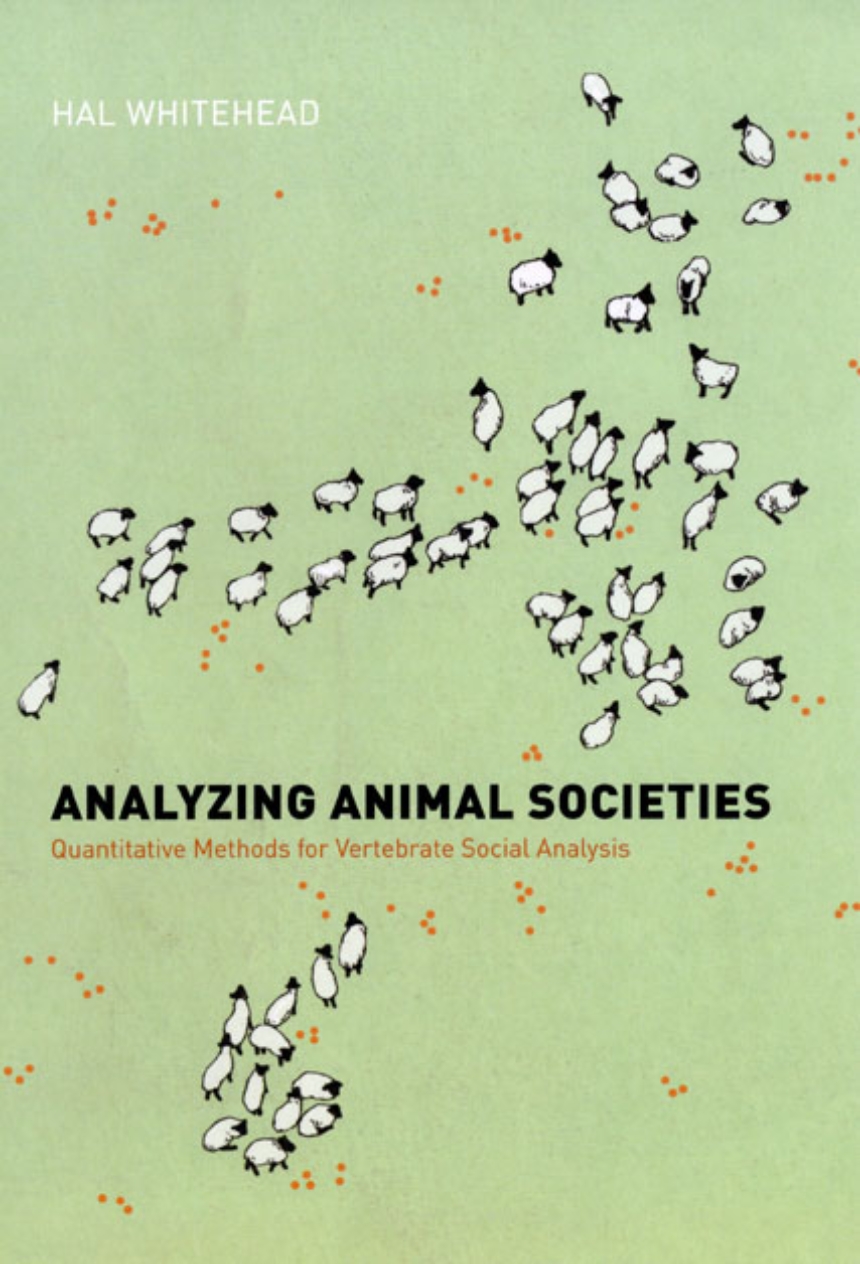Analyzing Animal Societies
Quantitative Methods for Vertebrate Social Analysis
Analyzing Animal Societies
Quantitative Methods for Vertebrate Social Analysis
Analyzing AnimalSocieties presents a conceptual framework for analyzing social behavior and demonstrates how to put this framework into practice by collecting suitable data on the interactions and associations of individuals so that relationships can be described, and, from these, models can be derived. In addition to presenting the tools, Hal Whitehead illustrates their applicability using a wide range of real data on a variety of animal species—from bats and chimps to dolphins and birds. The techniques that Whitehead describes will be profitably adopted by scientists working with primates, cetaceans, birds, and ungulates, but the tools can be used to study societies of invertebrates, amphibians, and even humans. Analyzing AnimalSocieties will become a standard reference for those studying vertebrate social behavior and will give to these studies the kind of quality standard already in use in other areas of the life sciences.
320 pages | 16 halftones, 28 line drawings, 59 tables | 6 x 9 | © 2008
Biological Sciences: Behavioral Biology, Biology--Systematics, Ecology, Evolutionary Biology
Reviews
Table of Contents
Acknowledgments
Conventions and Abbreviations
1: Analyzing Social Structure
1.1: Introduction
1.2: What Is Social Structure?
1.3: Why Social Structure Is Important
1.4: Conceptualizing Animal Societies: A Brief History
1.5: Ethology and Behavioral Ecology
1.6: Hinde’s Ethological Conceptual Framework of Social Structure
1.7: Other Definitions and Concepts of Social Structure
1.8: Elements and Measures of Social Structure
1.9: The Functional Why Questions, and Ecology
1.10: Examples of Social Analyses
1.11: Problems with Analyzing Social Structure
2: Technical Matters
2.1: Modes of Scientific Enquiry
2.2: Basic Descriptive Statistics
2.3: Precision of Statistics: Bootstraps and Jackknives
2.4: Hypothesis Testing
2.5: Data Matrices
2.6: Ordination
2.7: Classification
2.8: Model Fitting and Selection: the Method of Likelihood and the Akaike Information Criterion
2.9: Computer Programs
3: Observing Interactions and Associations: Collecting Data
3.1: Types of Behavior
3.2: Interactions
3.3: Associations
3.4: Groups
3.5: Identifying Individuals
3.6: Class Data
3.7: Collecting Social Data
3.8: Data Formats
3.9: Sampling Periods
3.10: Attributes of Data Sets
3.11: How Large a Data Set Is Needed for Social Analysis?
box 3.1: Precision and Power of Social Analysis
4: Describing Relationships
4.1: Relationships
4.2: Nonsocial Measures of Relationship
4.3: Social Attributes of Individuals, Including Gregariousness
4.4: Rates of Interaction
4.5: Association Indices
box 4.1: Choosing an Association Index: Recommendations
4.6: Temporal Patterning of Interactions/Associations
4.7: Relative Relationships: Multivariate Description of Relationships
4.8: Types of Relationships
4.9: “Special” Relationships: Permutation Tests for Preferred/Avoided Companionships
4.10: Quantifying the Strength of a Relationship and the Bond
4.11: Relationships between Classes
box 4.2: Describing Relationships: Recommendations
5: Describing and Modeling Social Structure
box 5.1: Omitting Individuals from Analyses of Social Structure
5.1: Attributes of Social Structure
5.2: Single-Measure Displays of Social Structure
box 5.2: Visual Displays of Social Structure: General Guidelines
5.3: Network Analysis
box 5.3: Network Analyses: Recommendations
5.4: Dominance Hierarchies
box 5.4: Analyzing Dominance Hierarchies: Recommendations
5.5: Adding Time: Lagged Association Rates
box 5.5: Lagged Association Rates: Recommendations and Extensions
5.6: Multivariate Methods
5.7: Delineating Groups, Units, Communities, and Tiers
box 5.6: Recommendations for Population Division
box 5.7: Describing Social Structure: Recommendations
6: Comparing Societies
6.1: Comparing Social Structures
6.2: Classifying Social Structures
6.3: How Complex Is My Society?
7: What Determines Social Structure, and What Does Social Structure Determine?
7.1: The Individual in Society: Roles
7.2: The Dyad in Society: Conflict
7.3: The Dyad in Society: Cooperation
box 7.1: Quantitative Methods in the Behavioral Ecology of Social Systems
7.4: Environmental Determinants of Social Systems
7.5: Mating Systems and Social Systems
7.6: Culture in Society
8: The Way Forward
8.1: Conceptual Frameworks
8.2: Subjects of Social Analysis
8.3: Collecting Better Data
8.4: Improving Analysis
9: Appendices
9.1: Glossary
9.2: A Key Journal and Some Useful Books
9.3: Computer Programs
9.4: Estimating Social Differentiation
9.5: Assessing Unit Size, Group Size, or Community Size
References
Index
